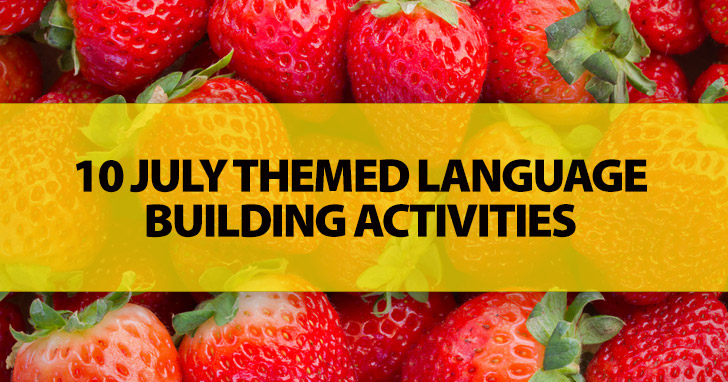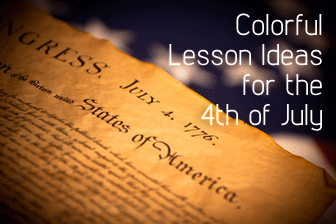10 July Themed Language Building Activities


Students are often curious about how America came to be an independent nation. History doesn’t have to be boring though. Just add some creativity and your Fourth of July lessons will be as colorful as sparklers and roman candles.

A fun way to weave in history into some of your lessons before the Fourth of July is to play the Red, White and Blue Challenge. The premise is pretty simple. You divide the class into three teams: Red, White and Blue. Each team answers questions like on a trivia game show. The trick to this game is that all the answers have to contain items that are red, white or blue. You can devise a point system for each color. Every correct answer automatically gets one point. Answers with white items get 2 points because they are a bit more difficult. You could also give ? a point for answers that are correct but that contain other colors or don’t have anything to with color. Some possible questions could be:
In order to play the Red, White and Blue Challenge successfully you will have to do some lessons on American independence, the founding fathers, and the Declaration of Independence. Think creatively when you are putting these lessons together. There are lots of options for making these lessons interactive. Be sure to consult the internet and find some videos or audio recordings about the above topics. There are some that are narrated from the standpoint of Ben Franklin or George Washington. You could then do fill in the blank exercises or have discussion about what they watched or listened to. Another idea would be to teach students some patriotic songs like the Star Spangled Banner or examine the Pledge of Allegiance. This could lead to a lot of discussion and beneficial new vocabulary. Once students have learned about the basic events leading up to the Fourth of you July you could have them draw out those events, and post their drawings around the classroom.
Everyone loves a good birthday party. Break out the streamers, candles, party hats and birthday cake. There are several ways you can organize America’s Birthday party. Assign each student a task like decorating, cleaning up, setting up, or last minute details. You can have the students sing happy birthday or even better, play some patriotic music and teach them the lyrics. The birthday party doesn’t have to be extravagant to be effective. During the party, you’ll want to have some amusing activities like pin the star on the flag or tell your favorite thing or fact about America. Students of all ages will enjoy playing games, and you can ask them what they think America would like as a gift this year. You can also discuss the age of the country and how America is a relatively young country and what that means. You’ll want to steer clear of politics but providing fun facts, trivia, and little known facts can also engage students.
Alien Invasion is another fun game to play to see how much the students remember about American history. Split the class in half. One half of the class will be the aliens and the other half will be the founding fathers who have time-traveled to the year 2012. The Aliens ask questions to the founding fathers. Because they are aliens they are unfamiliar with anything and everything American. You can give the aliens prompts to get them started. Questions can be as simple or as complex as the students can come up with from the previous lessons. It could start out with the aliens asking simple questions like: Where are we? What is this place? Who is the leader of this place? How big is it? Who lives here? What is there to eat? After a set period of time the aliens can then switch to play the role of the founding fathers. They can then continue from where they left off.
Too bad we can’t light fireworks off with our students. You can however do the next best thing; show them all the different types of fireworks and what they do. You can do this first by using photographs or a slideshow of some of the variety of fireworks. You can have students describe the different types by how they look, what they do, and how they sound. Some of the most popular fireworks include: sparklers, roman candles, rockets, pinwheels, cherry bombs, firecrackers, and fountains. Ask the students if they have ever been to a fireworks display. You can find a lot of resources on the internet for this if you want to play them a short video and see if they can identify some of the shapes and formations.
If you happen to be teaching somewhere where there is a fireworks show, you may want to do a lesson on how the fireworks are set-up and then what happens behind the scenes during the show. Often you can find excerpts from the local news channels that you could play for the class. Otherwise you could describe it for students and then have them explain the steps to putting on a large fireworks show.
Explaining the history behind a holiday doesn’t have to be dry or tedious if you think outside the box. Have you employed any similar strategies that got a bang for your Fourth of July Lessons?